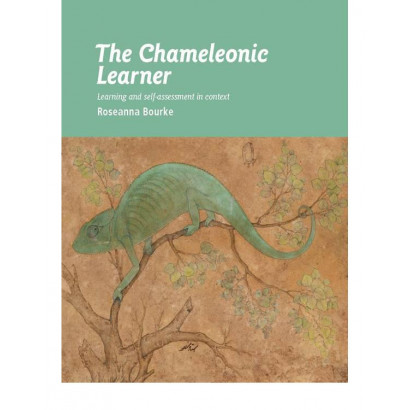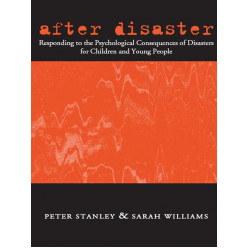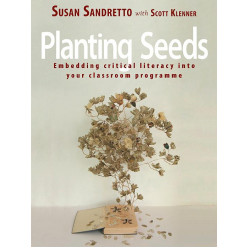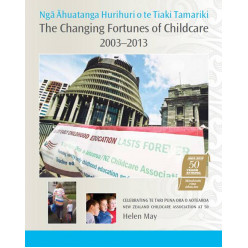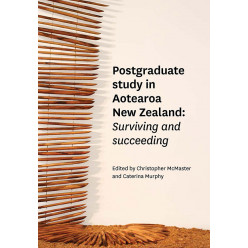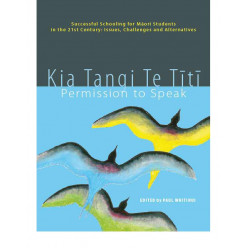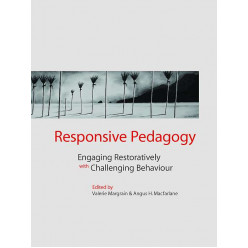The Chameleonic Learner
Immediate Download
Download this title immediately after purchase, and start reading straight away!
View Our Latest Ebooks
Explore our latest ebooks, catering to a wide range of reading tastes.
Author Dr Roseanna Bourke takes the reader on a fascinating exploration of learning: the theory, practice and young people’s take on it. What do you say to a young person who tells you her brain is an eighth full? Or to the one who says he only knows he has learned something when he receives a stamp or a sticker? This book is about how learners conceptualise learning, how they self-assess their own learning and why context matters. It shows how, just as a chameleon changes colour, learners change and adapt their approach to learning depending on the situation. It draws on examples of learning by Years 7–8 students from the classroom and out of school, looking at how their views and values are shaped and how they satisfy their own learning needs.
From: The Chameleonic Learner, by Dr Roseanna Bourke
Chapter 2: Changing the way we see student learning
Researchers who seriously engage in the work of seeking out, taking up, and re-presenting students’ experiences of school not only translate what they gather but are also translated by it. (Cook-Sather, 2007, p. 829)
Although researchers can spend time with learners, observing and recording and talking and interacting with them, teachers have the unique, first-hand experience of translating their own observations of their students grappling with learning activities. In this chapter, I explore ways teachers can understand learning in the classroom, as well as ways that require a more systematic focus when researching with learners. The question at the heart of this chapter is this: How do we inquire into student learning and translate their experiences of it?
Teacher as researcher
Whether we are teacher or researcher, it is important to realise that both provide different means of considering the phenomenon of learning, and that arguably both are needed to portray a full picture of what it means “to learn”. The metaphor of the chameleonic learner requires us to develop an understanding of student learning as “in the moment” and “in this context” (Nuthall, 2007), and constantly negotiated (Dyson, 2007). It also requires us to articulate the relationships between learners, their peers, their teachers and the activity. The focus of research or classroom inquiry by the teacher is thus on understanding learning rather than attempting to change that learning. If teachers are to change anything within a classroom context, their first step is to listen, watch, gather meaning and really understand what “learning” means in this context. Analysing learning and self-assessment in action is always an important aspect of teaching. The process of systematically looking at learning, examining and translating what we see and supporting learners to understand their own learning is the aim of classroom inquiry.
Understanding student learning within a formal educational context involves observations, conversations, careful questioning, constant listening and searching for ways to “see the world” through the mind of the learner. When we participate in a community, we contribute to change and are, in turn, changed by our dynamic interactions with others (Rogoff, 2003); thus, classroom inquiry enables change. By being willing to learn from students, those of us who are teachers and researchers intentionally change. If we view learning as something that happens only to students and that is measured by outcomes, then the teacher-learner relationship becomes a one-sided process of pulling students along. In the same way that learning is a process of changing conceptions—that is, changing the way we see things—teacher inquiry is about seeing our classrooms, our students and ourselves in a different way.
Systematic effort to understand learning means ensuring that the process of analysing and interpreting data collected within the classroom is characterised by attention to detail and rigour. Inquiry means uncovering and explaining what is happening. But teachers are not necessarily inclined to theorise or make explicit their interactions with learners. Classroom activities, and the learning within, are rarely public events, and constant verbal and nonverbal interactions with students allow teachers little time to think about, reflect on or write about their work for others to learn from. In contrast, classroom inquiry involves making these experiences public and therefore open to scrutiny. This is an important step in research (Stenhouse, 1981).
The starting point for teachers as classroom inquirers is to identify one aspect of their teaching that interests them and that they believe is pivotal to student learning. Initially, it does not matter whether that aspect is a way of relating, a form of assessment, a communication to parents or a conversation with students. Concentrating on something that interests them as a teacher will help bring the learning of students into focus. Significantly, the process will also focus on the teacher as learner.
When, as teachers, we are interested in the impact of the meanings of events for students rather than the effects of those particular events on students, we give credence to these perspectives:
• Students do their work on the basis of the meaning they give to it (not the meaning given by teachers or others).
• Students figure out what things mean to them by working, talking with and learning from their peers and teachers.
• These interactions adjust and change the way students think about things and their meanings.
Classroom inquiry into student learning must therefore appreciate the influence individuals have on different contexts and groups, as well as the influence these contexts and groups have on the individual.
The notion of “partnership” is essential when undertaking inquiry of this kind because the teacher relies in great part on interviews or structured conversations with the students in order to understand and learn about the focus of inquiry from the students’ experiences. In general, if this interview process is approached with sensitivity and care, most students are comfortable about talking. As Eisner (1998) notes, “It is surprising how much people are willing to say to those whom they believe are really willing to listen” (p. 183). Interviews can be an enriching experience for learners, too (Kvale, 1996).
The study in brief
The young people who took part in the study described in this book were in Year 7 and Year 8 at school. During the study, which I conducted in order to better understand how students conceptualise learning and self-assessment, I interviewed 26 students (15 males and 11 females) from three Year 7 classes in one intermediate school, and I involved seven of these students the following year, when they were in Year 8, in an ethnographic phase of study. During the first year, my interviews with the students ranged from 35 to 60 minutes. Interview time depended on the speed of the student’s utterances and the amount of information each student wanted to share. During the second year, I observed and interviewed Year 8 students in both school-based and out-of-school contexts. I also analysed relevant documents. I audiotaped and transcribed verbatim all interviews conducted across the two phases of the study.
My analysis of the Year 7 transcripts began with no predetermined framework and involved an iterative process in which I read the transcripts several times, first to identify categories of learning, and second to identify categories of self-assessment. In many cases, I found instances of students talking about learning something and simultaneously explaining how or when they knew they had learnt (an example of self-assessment). I explored these transcripts in terms of the students’ conceptions of both learning and self-assessment. The categories of description that I eventually drew out (see Chapters 4 and 6) move from least sophisticated and least inclusive views to most sophisticated and inclusive views, thereby providing hierarchical models for conceptions of both learning and self-assessment.
Discussing learning with students
Interviews, conversations, dialogue and “talking to kids” invariably involves questioning. The careful selection and phrasing of questions can greatly affect what we can learn from students and how we help them think about their own learning. The questions we ask and the way we frame these create different response possibilities, which is why I decided to use a semistructured interview schedule with additional questions generated on the basis of the students’ responses. Therefore, while the structure within each interview was predetermined, no two interviews were the same.
I also made careful and systematic use of probe questions to help students clarify, elaborate on or explain their responses. While probe questions do not necessarily contain much in their structure or content, they are useful because they encourage participants to amplify or clarify their explanations. Examples of probe questions include:
• Would you say something more about …?
• What do you mean by that?
• Can you give me an example?
• Could you clarify what you mean?
An example of opening up a conversation about learning with a student, young or old, is as simple as asking them what learning is. This is not a closed question, and can involve all curriculum areas. For the child, talking about learning is usually novel, at least in part because they have not thought about or articulated their understanding of it as a phenomenon. They usually have discussions about what they have learnt, what their learning intentions are and what the results of assessment show they have learnt, but not what learning is for them.
I began each interview with this question: “When you knew we were going to talk about learning, what did you think we’d talk about?” The children’s initial responses located them firmly in a school-bound context. Examples included:
• I thought study, something like that.
• What we liked about the school, what we learn and stuff.
• I don’t know, school.
• I wasn’t really sure. Subjects and stuff.
• School work, anything to do with learning, like what I do on the average day.
• Finding out things. Researching.
• About what the working environment was like, and what sort of things we learnt in a certain curriculum.
• Spelling and times tables and all that and division.
• What I do when I do maths and reading.
• How you like school and what subject you like, and how the school works.
• Education and stuff.
These typical responses show how students tend not to think about learning beyond school-based learning—until, that is, they are prompted later in the conversation with “Does learning happen anywhere else?” But, having taken that school-based thinking as a first step, learners open up their ideas and think about what learning actually is.
What do you mean?
Talking with students allows us to continually explore the meaning they attribute to a topic. While students in this study used a common language when talking about learning within school, they often placed different meanings on these ideas. We all use words that explain or elaborate an idea; usually, we know what we mean, and the word itself generates further, multiple layers of meaning encapsulating personal history and context. Take the word “gay”, for example. Young people today use this word as an adjective to describe something they do not particularly value or like; they are not referring to a form of gaiety, nor to the sexual orientation of a person. They may exclaim, “That story’s so gay,” or question your sartorial sense by asking, “Why are you wearing those gay trousers?” In these cases, they respect neither the story nor the trousers; they think they are stupid, dumb, oldfashioned—and here, too, we are using words that have multiple meanings for each person.
When young skateboarders at a skateboarding park were asked about the use of the term “gay”, they described it as concealing jealousy while congratulating their peers on stunts. As one of them explained, “If he’s doing a trick that I can’t do, I’ll probably call him gay or something because I can’t do it.” Said another, “In all honesty, what it is, is like to express a form of slight jealousy, but at the same time, you’re, like, wow, my friend just did that. That’s awesome! It’s almost like saying, ‘Man, I can’t believe you just did that, I wish I could do that.’ In all honesty, it’s not portrayed as negativity in most scenarios up here” (Petrone, 2010, p. 126).
So, when talking with young people, it is important to constantly check what they mean by their language, because adults often receive messages very different from those intended. We cannot assume that when students refer to learning or assessment, or use the words “boring”, “fun”, “cool”, our understanding of these terms coincides with theirs. The young people in this book often used the word “boring”, making it necessary to ask, “When you say boring, what do you mean?” For example, one student clarified boring as work that is too hard. Another referred to work considered too mundane and repetitive.
Interestingly, students in a study conducted by Pollard, Broadfoot, Croll, Osborn, and Abbott (1994) were more likely to define boring as “teacher-framed work” and work that involved “doing what the teacher says” (p. 173). The students in Filer’s (1997) study used boring in relation to news items presented to the class in a manner that would please the teacher, rather than in a comedic form that would appeal to their peers. Boring was identified in Anthony’s (1994) study of secondary school students in a mathematics context as, “the result of the work being too hard or uninteresting” (p. 230). It seems that, in a school context, students who do not always appreciate the point of learning an isolated spelling word or a particular multiplication table tend to refer to learning as boring.
In the study in this book, learners used the words “practice” and “boring” in different ways depending on their conception of learning. For a student with a less sophisticated view of learning, practice meant remembering facts for later recall; for a student with a more sophisticated view of learning, practice involved applying the knowledge and skills to a new task. However, these meanings also changed according to context, so for the same learner practice could mean different things. For one learner, practice in trampolining was different from practice in spelling. For those learners with a sophisticated conception of learning, boring meant repetitive, arduous tasks undertaken when they already understood a concept; for others, it meant a difficult task that they did not understand. Some students used the term “boring” when they did not see or value the point of the learning. The implication for teachers is the need to discover the learners’ understanding of a task or word because it determines the way they approach the task.
Boring is when the activity is compulsory | At school, some of the time it’s boring and some of the time it’s fun, and whenever you’re at home it’s always fun because you like doing it because you can just give up on it whenever you like. So if it’s boring, you just say, ‘I don’t want to do this anymore,’ and you just give up on it and do something else. |
Boring is when there is no perceived relevancy | Cause, if it’s boring, well, you’re just writing it out and writing down the answer, and it’s boring. And if it’s fun, well, you actually get into it and do it properly. |
Boring is when the activity is not practical | If you get to do something … because, like, in maths, you don’t get actually something, you just get the knowledge—that’s real boring. |
Boring is practising a skill or concept you already understand | R: So what do you mean by boring? S: |
We can clarify the meaning and interpretation students give to concepts by:
1. requesting examples of what the student is saying
2. asking students directly what they mean by certain things
3. creating links between events and settings (such as home and school learning)
4. constantly checking for shared meaning—even if the words used are the same. For example, teachers can more easily develop a shared understanding of how to change their teaching when they understand that “boring” for one child means repetitive but for another means too hard
5. exploring a concept in different and multiple ways. For example, when focusing on issues about assessment, we can ask students how they knew when and how they had learnt, and whether they knew before the teacher (or parent) that learning had occurred.
Listening for the metaphors
It is very interesting to listen for the metaphors students choose when they talk about their learning. For students, metaphors provide a way of explaining and describing their experiences and understanding when words alone are not enough. Students may refer to tape recorders when discussing memorising information, or clouds when discussing knowledge. Dall’Alba (1994) said that students in her study “used rich metaphors to capture their understanding of what learning is” (p. 79). Teachers can use these metaphors to help students clarify ideas and explain complex issues. Among the metaphors the young learners in my study used were these:
Your mind’s like a tape recorder, like, that we’re on now, and it just takes in the information and you don’t even really know you’ve got it. That’s how I find it … You’re mostly recording something all the time because, like, I’ll remember talking to you now, so I’ve basically recorded it because I’ve remembered I’ve been talking to you.
Knowledge is like a cloud, a bubble, you don’t even know what it is … I think you always have a knowledge when you were born to do stuff … I think you always have it there, and then when you’re told it, you’re kind of, you take it in and then remember it, and then you might let it out, but you always keep it there.
It’s like a file, one of those file cabinets, and you, like, you just pull it out of your mind like a file cabinet, and you pull something out …
[R: If you can’t pull it out?]
That means you haven’t learnt it.
Observing in the classroom
Effective teachers are keen and constant observers. Usually, they see the makeup of the milieu as it unfolds in front of them in multidimensional mode. They keep track of the learner reading in front of them, the group activity to the side, the students working independently, the child running his ruler alongside the windowpane and listening to the sound, the child with her fingers in her pencil case scrabbling for her pencil. Another student ambles by and asks a question; meanwhile, the teacher notes the two children seated side by side at the computer. Scanning the periphery, seeing the learning activity around the classroom, is what a teacher constantly does.
Part of the nature of this observation involves parallel analysis of what is going on—knowing when to intervene, remain silent, glare, smile in encouragement, show mock horror, ask questions, make comments, tell a joke. Observations thus require some form of analysis that leads to a chosen form of action. It is the analysis component of the observation that translates the “seen” and “scene” activity to a teaching activity, and progressively to a research or inquiry approach. For example, a teacher may see an activity in action, say, a group of young children gathered around a desk examining a reading book. But unless that teacher does some measure of analysis (even subconsciously) of what, how, when and where learning is occurring for these children, then teaching is less likely to take place.
While a teacher’s analysis of everyday observations in a classroom is not always transparent, it nevertheless marks the difference between (a) a quick scan around the room to check students are on task and (b) active teaching. Teachers’ informed decisions and judgements about their day-to-day teaching, often derived from observational data, draw on a range of strategies including memory, interpretation, learning theory and motivation theory:
• Memory: Teachers cannot remember every interaction and event that occurs in a classroom. Usually what they recall are those events that had a strong emotional effect on them or that fell outside their regular classroom routine. A teacher might recall the day the child overturned a desk but not the book that made the child upset. The teacher might recall feeling elated when Martin finally grasped complex equations but not remember the earlier occasion when he understood fractions, something he was very excited about. Because, during an analysis, ability to recall events, days, times and people is important, keeping a daily diary over a short period (e.g., a month) will help teachers track what actually happened.
• Interpretation: When teachers recall an event and situation, they view it through the lens of their interpretation and understanding; they derive particular meaning from what they observe and remember. Teachers thus remember less about the activity and more about the meaning they give to the event. In many cases, this interpretation remains the teacher’s view and does not capture the learner’s intention or reason for her behaviour. Consequently, if the interpretation is to faithfully represent the learning, the teacher needs to consider the meaning behind the child’s intent and the context in which the child engaged in the activity.
• Learning theory: All teachers theorise their teaching and learning, but often subconsciously. They may make decisions and judgements about what is happening according to what they think “learning” is. Analysis helps teachers reflect on their learning theories and determine whether their own interpretation includes other ways of seeing learning. On what basis is their judgement sound? Should they challenge that judgement?
• Motivation theory: In general, children do want to learn, succeed and feel good about themselves. They want to learn and to live. In official discourse, this desire is often referred to as being “engaged” in learning. Student engagement is not an issue if children love to learn, feel secure in their learning environment and enjoy the challenge of the unknown. Teachers analysing an event from the perspective of motivation need to ask these sorts of question:
– “Why did Joe choose to do this?”
– “How can I support Joe to be more energetic in his work?”
– “Does Joe view this work as relevant and what parts does he value?”
Observing outside the classroom
Realistically, teachers can observe only a small part of what, how and when young people learn outside the classroom. When observing young people in their school-based out-of-classroom contexts (the hall, drama room, fields, netball courts, playground and so on), we see how different social and learning settings influence the students’ interactions with others and contribute to their growth of self-awareness and identity. Subsequently, our understanding of these students is far greater. The student a teacher sees in mathematics is not the same student when participating in sport. The student may be seen as competitive and tenacious in one context and a struggling learner in another. Students do not generally know to look at their learning of abseiling and to use these principles in science, yet they are the same learner.
Out-of-school settings influence how young people learn and they also influence how young people think about learning. To develop an inclusive understanding of learning, we need to explore these out-of-classroom and out-of-school contexts with the learners. When it is not possible to observe learners in multiple contexts, questions can help:
• “Can you tell me where else you learn?”
• “Can you tell me something you have learnt out of school this year?”
• “How did you know when you had learnt it?”
Learners’ responses to and interactions with environments outside and within formal contexts differ. The most interesting part of observing learners in out-of-classroom contexts is seeing what cues they respond to, and why. Several factors affect their decisions, including their personal goals and motivation, their peer group, the level of adult participation (teacher, parent, instructor) and the context within which the activity is framed. Students learning to count to 10 in Japanese learn differently in a classroom context in which the aim is to learn Japanese as a language, compared to a judo context where learning to count to 10 in Japanese is part of a routine.
Bringing to the fore what is to be analysed
Each classroom is a rich, diverse, lively environment in which to observe learning. We can choose to observe the whole or parts of that whole. For example, we can observe individual learning and focus on one or two learners, or we can observe pairs or clusters of learners or we can take a whole-class view. The metaphorical lens we use to observe in an educational context is shaped by our understanding and theoretical position of learning and what we highlight in our observations; hence creating a picture of learning at that moment. What is brought to the fore and what we choose to place in the background make a difference. Thus, while the general context remains an integral part of the activity, it is what we focus on or highlight that is of interest. Our choice depends on the focus of the classroom inquiry.
Summary
In this chapter, I outlined some of the ways teachers can begin to explore and understand student learning rather than merely “measure” it. Teachers who understand learning—and learners—can help their students make sense of what they are doing and why. In order to understand student learning, teachers need to be multiskilled in observing, listening, questioning, interpreting, analysing and articulating what they see. This work is complex and intricate when positioned alongside teaching, but for many teachers this is teaching. Teacher inquiry is more like research activities than many teachers realise. By adjusting some components of what they already do, teachers can easily embark on systematic inquiry into student learning. The next chapter provides a theoretical framework on learning and provides a context that leads into the students’ conceptions of learning presented in Chapter 4.
